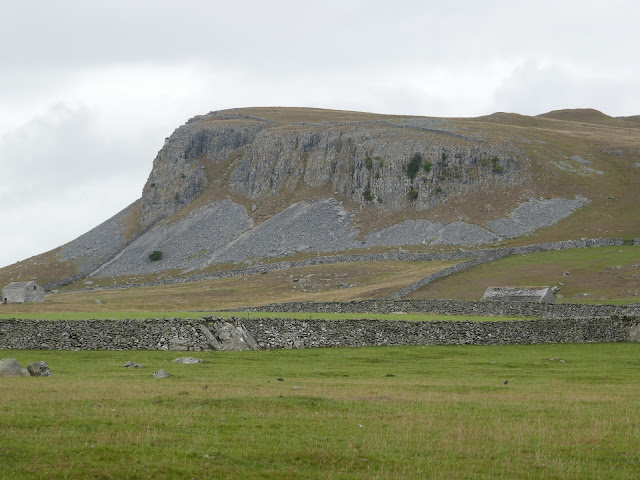This map was created using GPS Visualizer's do-it-yourself geographic utilities.
Please wait while the map data loads...
Route: Austwick, Town Head, Thwaite Lane, Long Lane, Trow Gill, Gaping Gill, Little Ingleborough, Ingleborough, Swine Trail, Dales High Way, Nick Pot, Sulber, Sulber Gate, Thieves Moss, Beggar's Stile, Moughton Scars, Capple Bank, Moughton, Hunterstye, Wash Dub, Crummack Lane, Austwick
From: Austwick
Parking: Roadside parking in Austwick
Start Point: Austwick
Region: Yorkshire Dale - Southern Fells
Route length: 12.8 miles (20.6km)
Time taken: 05:11
Average speed: 2.5 mph
Ascent: 811m
Descent: 815m
Summits: Ingleborough (723m), Moughton (427m)
Other points of interest: Trow Gill, Gaping Gill, Thieves Moss, Moughton Scars
Ingleborough was once thought to be the highest mountain in England, which it is far from. It is, however, one of the more impressive, thanks to its distinct profile. You could consider it my 'local' mountain - it's only a short drive from Leeds and ideal if the weather looks a bit 'iffy', as today was looking.
Ingleborough can be climbed for a number of locations, Clapham or Ribblehead are the two most popular ones. My choice this time was the quiet village of Austwick which allows you to incorporate the vast limestone pavements of Moughton Scars into a long, interesting circular walk.
Heading north out of Austwick, I followed Crummack Lane to a crossroad with Thwaite Lane, taking a left along the Pennine Bridleway. Robin Proctor's Scar painted a magnificent scene as the sun made an appearance. Behind the scar are the famed Norber Erratics, a place I visited not too long ago though you could say the weather was slightly different on that occasion.
 |
| Studrigg Scar |
 |
| Robin Proctor's Scar |
 |
| Robin Proctor's Scar |
 |
| Thwaite Lane |
 |
| Robin Proctor's Scar |
 |
| Thwaite Lane |
 |
| Long Lane with Simon Fell in the distance |
 |
| Long Lane |
 |
| The Ingleborough Cave |
 |
| Trow Gill hides behind the trees |
 |
| Trow Gill |
 |
| Trow Gill |
 |
| Trow Gill |
The ravine narrows towards the end and a few stepped rocks allow you to climb out the other side. The next port of call would be Gaping Gill.
 |
| Exiting Trow Gill |
 |
| The bridleway at Clapham Bottoms |
 |
| Ingleborough |
 |
| The path deviates towards Gaping Gill |
 |
| Fell Beck |
 |
| Gaping Gill |
 |
| Fell Beck disappears into the hole.... |
 |
| Path to Little Ingleborough |
 |
| Pen-y-Ghent |
 |
| Clapham Bottoms panorama |
 |
| Simon Fell |
 |
| Ingleborough from Little Ingleborough |
 |
| Little Ingleborough |
 |
| Clapham Bents |
The summit is adorned with that most characteristic of objects, the OS trig pillar, along with a substantial cross shelter and a few large piles of stones. The views from around the summit are spectacular. On a clear day, they stretch away in all directions and are especially good viewed to the north and the west.
 |
| Ingleborough's summit |
 |
| Cairn and wind shelter |
 |
| Ingleborough's shelter |
 |
| Whernside |
 |
| The Arks |
 |
| Simon Fell |
 |
| Looking back to Ingleborough |
 |
| The path at Fell Beck Head |
 |
| Looking across to Pen-y-Ghent |
 |
| Pen-y-Ghent |
 |
| The area known as The Allotment |
 |
| Sulber Nick |
 |
| The limestone pavement at Sulber |
 |
| Leaving the Three Peaks route |
 |
| Sulber gate |
 |
| Thieves Moss |
 |
| Moughton Scars |
 |
| Moughton Scars |
 |
| Beggar's Stile |
 |
| Moughton Scars |
 |
| Moughton Scars |
 |
| Moughton Scars |
 |
| Ingleborough |
 |
| Showers over the Forest of Bowland |
 |
| Cairn at Capple Bank |
 |
| Austwick Beck Head and Capple Bank |
 |
| A slight change in scenery |
 |
| Ingleborough over Crummack Dale |
 |
| Moughton trig pillar |
 |
| Approaching showers |
 |
| Heather at Moughton |
 |
| Studrigg Scar |
 |
| Walled lane in Crummack Dale |
 |
| Austwick Beck |
 |
| Wash Dub |
 |
| More rain incoming |

No comments :
Post a Comment